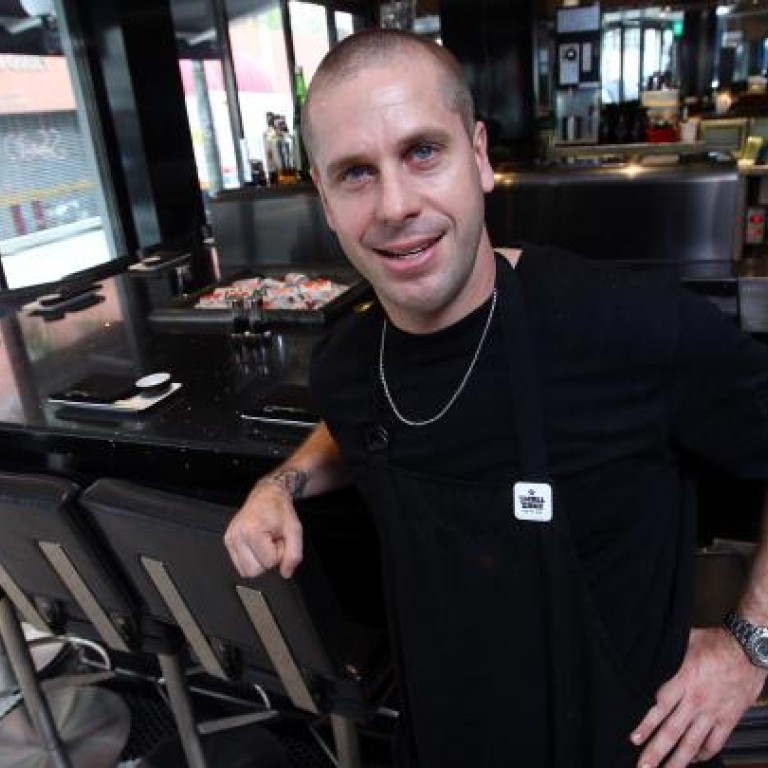
A Japanese story: my life on a plate
It took a high school exchange trip to Japan and some nudging from his mother for the head chef and co-owner of Sushi O to pursue a culinary career. Ian Persi - or just Persi, as he prefers to be called ("only my mother calls me Ian") - has a passion for his craft. He also has a palpable sense of excitement about being a co-owner and the prospect of a second branch of the restaurant opening within two years.
"Having my own place means that I control my environment, from the menu to the music I play, to creating a casual, fun ambience and taking care of customers," he says. "I really enjoy giving guests the accumulation of 20 years' experience in Japanese cuisine and showing diners who I am through my food."
The story of how Persi, 37, came to accumulate that experience - including time spent working in Japan, where learning the cuisine is still largely closed to foreigners - began in his hometown of Sydney. He began studying Japanese in high school, uncommon at that time, because "it almost felt like a higher power was influencing me to study Japanese".
At 15, he spent three months in Nagoya, Japan, as an exchange student. After finishing high school, he returned to Nagoya and spent a year surfing, working in menial restaurant jobs and perfecting his Japanese.
When he returned to Sydney, unsure of what he wanted to do, he took a job on a commercial fishing boat. It wasn't long before he had a chance to return to Japan. After some travel, the 19-year-old settled in Kamogawa, again securing a commercial fishing job.
"I was a bit of a novelty among the locals," he says. "I was the only non-Japanese living in the city then, enthusiastic and definitely cheeky, but I spoke the language, and I was fitting in with them - not the other way around - and I was prepared to work hard."
Persi then spent about a month pestering the head chef of the Kamogawa Grand Hotel, where he was staying (even giving him gifts of fresh fish), until he was offered a job as a radish peeler and frozen goods handler. He spent three years in the hotel kitchen, slowly working his way up.
Even when he returned to Sydney, he hadn't made up his mind to pursue a career as a Japanese cuisine chef. "I was planning to study Japanese at university with the intention of becoming a translator or teacher and returning to Japan, but mum suggested that after the Kamogawa experience I should pursue cooking," he says.
He took her advice and did a four-year, part-time course in commercial cookery while working at the now defunct Kamogawa restaurant in Sydney. He stayed to help open a noted sushi bar called Sushi e, where he worked for 10 years, most of that time as head chef.
It was there Persi came to know diners Wayne and Andrea Parfitt, the couple behind Castelo Concepts restaurant group, which includes Oolaa, Wagyu and Jaspa's. "I didn't know they were in the restaurant business, though, until they approached me about opening Sushi O," he says.
He came to Hong Kong last year in March to explore the idea. "I was at a point in my life where I was looking for something new, so I decided to go for it. It just seemed like the right thing at the right time," he says. The restaurant opened in Sheung Wan last October.
The menu includes both a traditional take on Japanese cuisine and Persi's modern spin. He calls it Japonification.
"The dishes reflect my life experiences on a plate," he says, and that includes travel.
One is his signature, papaya salmon - thinly sliced salmon with papaya and a Balinese-inspired salsa featuring flavours he associates with surfing trips to Bali, such as lemon grass, coriander and mint. His Italian heritage features in what he playfully describes as the godfather of sushi ("seared tuna belly with a hint of mafioso"), his take on a caprese salad.
The reflection of his personal history in the dishes extends to his dessert of tempura strawberries with coconut ice cream and cinnamon. "I came up with the idea when I was 18, but only now does it feel appropriate to introduce it," he says. "It is my recipe, my intellectual property, which you have to protect. If I'd shared this while working for someone else, the recipe would no longer have been mine."
